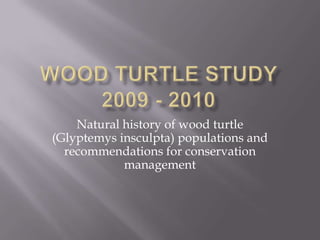
Wood turtle study 2009 2010
- 1. Wood Turtle Study 2009 - 2010 Natural history of wood turtle (Glyptemys insculpta) populations and recommendations for conservation management
- 2. “Fred” – 20 yr. old male This was the first wood turtle we found in 2009. Only 3 of 16 wood turtles found at the main site in 2009 were male. One of the questions we are working to answer is whether a small number of adult males is a problem.
- 3. “You can’t see me” Wood turtles cannot close their shells but pull their front legs in tight to protect their heads. The bright orange coloration appeared common throughout the spring / early summer.
- 4. A marked turtle from 1995 2009 Carving the date into the bottom shell has been common historically throughout the northeast. The opportunity to find dated turtles is a unique feature of our study. 1995
- 5. A turtle marked 30+ yrs. ago This turtle is about 45 years old.
- 6. The oldest wood turtle This male is about 70 years old, based on the wear of the shell*, making him the oldest wood turtle we’ve found In this study. * Based on Michael T. Jones, 2009, Dissertation, University of Massachusetts.
- 7. Photo I.D. Each turtle found is photographed top, bottom, front, and back so that the health of the individual can be assessed later. Photo: C. Volonte 2009 We keep a photo I.D. catalog allowing us to compare photos over time.
- 8. Measuring Dome Height Dome height is measured on each individual found, as is top/bottom width and length. Measurements can be compared next season for growth.
- 9. Job Hazards Getting wet is one of the very few hazards associated with researching wood turtles. However, we did learn a few things about finding bees nests in the first season as well! Photo: S. Ludlow, 2009
- 10. Turtle Tracks Tracks in sand are a sure sign of recent turtle activity.
- 11. Small female ~ 10 yrs. This young female is in perfect condition. The 3D effect of the growth rings is striking and provides a fair estimate of the turtle’s age. The individual ages are recorded to help us judge the health of the population.
- 12. Transmitter attached The transmitter is held onto the upper shell by epoxy. The epoxy does not injure the shell and can be pried off when needed. The antenna is extremely flexible and does not appear to impede the turtle’s movement in any way.
- 13. Radio-tracking Habitat use is calculated by using radio-telemetry to located turtles. The turtles are handled at the beginning of the season, and again at the end of the season, minimizing disturbance.
- 14. Initial Data Habitat Use The buffer line shown represents the NH 250 ft. Shoreland Buffer. In the first season, we found that the turtles were outside that buffer nearly 50% of the time. Incidentally, the stream shown is too small to qualify for Shoreland Protection.
- 15. Summary Initial data has shown that the wood turtles we tracked traveled outside a 76m buffer nearly 50% of the time. 76m is the current NH Shoreland Protection Zone for streams 4th order and larger. That means that the wood turtles and their habitat have protection only 50% of the time. It is an issue that can best be addressed locally – Conservation Commissions, conservation easements, and town warrants. Photo: C. Volonte 2009
- 17. American Wildlife Conservation Fund
- 19. Swanzey, NH, Conservation Commission
- 20. Western NY Herpetological Society
